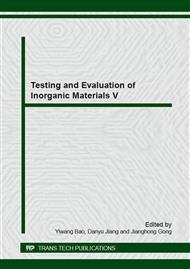p.269
p.273
p.277
p.281
p.286
p.290
p.295
p.299
p.303
Influence of Different Diameters and Materials of Posts on the Fracture Resistance of Endodontically Treated Teeth
Abstract:
Objective: To evaluate the fracture resistance of endodontically treated teeth reinforced with cast titanium posts and prefabricated glass-fiber posts with different diameters. Materials and Methods: 50 recently extracted human maxillary central incisors were endodontically treated and randomly divided into 5 groups of 10 specimens each: Group A: 1.35mm diameter of cast titanium post; Group B: 1.5mm diameter of cast titanium post; Group C: 1.375mm diameter of prefabricated fiber post; Group D: 1.5mm diameter of prefabricated fiber post; Group E: resin restoration. All specimens were subjected to fracture resistance testing in a universal testing machine, statistical analysis was performed and the fracture modes were analyzed. Results: The mean fracture resistance of five groups as follows: 404.22±73.92N for group A, 488.17±78.68N for group B, 280.32±45.23N for group C, 317.53±50.87N for group D, 222.76±38.67N for group E. The fracture resistance of restored teeth between group C and group D had no significant difference (P>0.05). The fracture resistance of the rest pairwise group comparisons had significant difference (P<0.05). Most of cast post samples fractured at the root middle or apical portion, while most of the fiber post samples fractured at the root cervical or post fracture, which could be retreated. Conclusion: Human maxillary central incisors restored with cast posts could bear higher fracture load and fiber post could protect the root from fracture preferably.
Info:
Periodical:
Pages:
286-289
Citation:
Online since:
November 2014
Authors:
Keywords:
Price:
Сopyright:
© 2015 Trans Tech Publications Ltd. All Rights Reserved
Share:
Citation:


